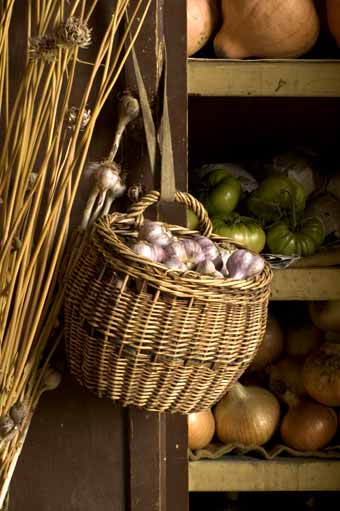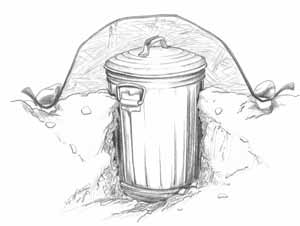


I grew up in Utah during the era of the cold war. Not only did our Mormon faith prompt us to keep a two-year supply of food on hand, we were also encouraged to have a family fallout shelter. Thankfully for my family, our hand-dug, dirt-floor fallout shelter underneath our basement staircase ended up a glorified root cellar that we filled with vegetables every year instead of one “nuclear family” sitting around like spuds in the dark. Dark and moist is good for potatoes, but not for people.
A root cellar is nothing more than some sort of underground containment — even a container buried in the ground works. The warmth of the surrounding earth keeps the vegetables (root crops) inside the container free from frost. It needn’t be elaborate, because a dirt floor is actually ideal. The dampness of the earth provides the moisture that most root crops need. A vent pipe in the top is a good idea, but don’t let that complication keep you from simply burying a garbage can out back and then covering it with straw and a layer of plastic. Even an old refrigerator with the latch removed and then laid on its back in a hole the size and depth of the refrigerator will work. (Removing the latch is essential in case a curious kid decides to play hide-and-seek there. It’s also essential to pick up an old refrigerator or chest freezer from an appliance shop that has had the motor, and hence the cooling gases, removed.)
For most crops, the ideal temperature you’re shooting for is 40–55 degrees — the cooler, the better. Potatoes, beets, carrots, turnips, parsnips, sunchokes, celeriac, kohlrabi and rutabagas work well in this type of underground storage. These kinds of vegetables are biennial plants that flower and set seed during the following season, meaning they’re programmed for long storage and they are the easiest to store. Heads of cabbage also store well in this type of root cellar, but I prefer turning mine into sauerkraut (see my “Plateful” Issue for details on how to ferment vegetables).
Crops like garlic and onions, squash, pumpkins and sweet potatoes need lower humidity (or they mold), and can tolerate a higher temperature, as high as 60 degrees, so I keep mine in a concrete basement where the air is drier. But no light for these vegetables either. Fruits like apples prefer more moisture, but you can’t keep potatoes and apples together in the same room. The ripening apples give off a gas that will make your potatoes sprout prematurely. To store apples in a basement, I’ve had good luck wrapping each apple in a square of brown kraft paper and placing them in an old-fashioned wooden bushel basket. I do the same thing with my green tomatoes.
I highly recommend wooden “bushel” baskets for everything you store. They were invented for this purpose. They allow air to circulate from top to bottom. A wooden basket breathes, and that’s what fruit and vegetables like. You can buy different size baskets from the Greenfield Basket Factory, 800-basket5,
www.greenfieldbasket.com. Greenfield has been manufacturing and selling baskets for farm enterprises since 1933.
Prior to supercenters and vegetables that travel thousands of miles before they’re eaten, growing, harvesting and preserving food was important work. Now that gardens and small farms are making a comeback, so is root cellaring. Since it’s the next best thing to fresh-picked, it’s surprising that root cellaring ever fell out of fashion. The flavor and texture of vegetables change very little while they’re in storage, and they retain most of their nutritional value, more so than when they are canned or blanched and frozen.
The primary purpose of roots is to anchor plants to the earth. A good root cellar full of root crops will anchor you to nourishing food and work that is real.
Find more simple solutions in MaryJanesFarm magazine. Click here to find out how to order your copy today.